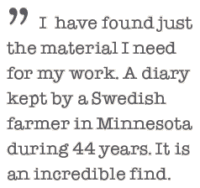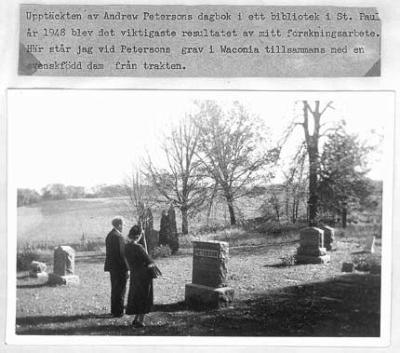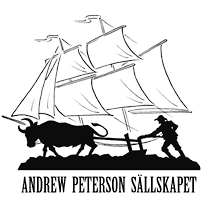When Vilhelm Moberg wrote his Emigrant Novels he spent some years from 1948 in the U.S. He prepared his novelwritings with research in The U.S. during 1948.
 Shortly after arriving in Minnesota he came in contact with Andrew Peterson’s diaries.
Shortly after arriving in Minnesota he came in contact with Andrew Peterson’s diaries.
In a letter from Minneapolis the 7 of July 1948 to his friend Edgar Swensson he is very excited after having discovered Andrews diaries, and he writes, (translated from Swedish):
“ I have found just the material I need for my work. A diary kept by a Swedish farmer in Minnesota during 44 years. It is an incredible find.
I went to Waconia in Carver County, 30 miles from here, and there I heard about an old farmer who had been keeping a diary all his life in America until the day before he died.
I discovered that the diary was to be found in the Minnesota Historical Society Library in S:t Paul. Eventually the librarian hunted up 10 complete volumes, around 4000 handwritten large pages. What about that? I could hardly belive my eyes.
 Vilhelm Moberg in front of Andrew Petersons familygrave, and Mobergs own words concerning his research before writing his emigrantnovels above the photo translated: ”The discovery of Andrew Petersons diary in a library in Saint Paul 1948 was the most important result of my research. Here I am standing at Petersons grave with a Swedish born lady from the neighborhood”In Sweden we have nothing equivalent to this diary kept by a farmer.
Vilhelm Moberg in front of Andrew Petersons familygrave, and Mobergs own words concerning his research before writing his emigrantnovels above the photo translated: ”The discovery of Andrew Petersons diary in a library in Saint Paul 1948 was the most important result of my research. Here I am standing at Petersons grave with a Swedish born lady from the neighborhood”In Sweden we have nothing equivalent to this diary kept by a farmer.
The diary completely pictures the life of a Swedish farmer in America during the pioneer days – excactly the firsthand material I was looking for”
Much more in Swedish can be read in this letter about Mobergs happiness over having “discovered” Andrew’s diaries. The letter is published in Vilhelm Moberg Society’s book: ”Om gud vill och hälsan varar”, (printed 2007).
In his book ’The unknown family” (Bonniers, 1950) Moberg describes how he visited the Minnesota Historical Library in St Paul. When Moberg asked for material about Minnesota’s Swedish immigrants, the librarian gave him three volumes of the Peterson diaries. Moberg immediately realized the importance of what he had found, which he also mentions in ’The unknown family’, where he writes: ”This huge diary seems to be of priceless value to our knowledge of the first Swedish settlement in the Midwest.”
 In the April 1966 issue of the Swedish Pioneer Moberg wrote an article about his emigrant novels, where he says: ”In the historical library of St. Paul~ I made my most important discovery.” And he continues:
In the April 1966 issue of the Swedish Pioneer Moberg wrote an article about his emigrant novels, where he says: ”In the historical library of St. Paul~ I made my most important discovery.” And he continues:
”In the work of Andrew Peterson I had discovered what I was looking for in America.
For several months I was sitting in the library of St. Paul to read about this Swedish farmer, to know what he had done, to know what he thought of life in this world. I read about his wife, his nine children, his cattle and his crops, his churchlife. When I finished to read the diary I had all the information I could use about a farmer’s life in the first Swedish settlements in Minnesota.”
There are hundreds of similarities in Andrews life and surroundings compared with Mobergs Emigrant–novel’s. Many can be found in Professor Roger Mc Knights Thesis:
“Influences and Paralells Andrew Peterson Diaries – V. Moberg Emigrant-novels”
The Andrew Peterson Society in Sweden has during the last years made an extended research about Andrews life concerning: The Diaries, surroundings, bookkeeping and letters. This research have resulted in that it is now easy to read Andrews diaries and bookeeping, and understand how Moberg used it when he wrote his Novel’s.
All this work can be found in the Andrew Peterson Society’s exhibition in Ydre Sweden.
It has also resulted in a book written in Swedish by Tord Ericsson about Andrew Peterson’s and F.O. Nilson’s first 10 years in the U.S.
Finaly our Society has made a book / booklet called:
“Andrew Peterson – The original Karl Oscar – 100 similarities”
Some of this similarities you can read below, and you can read many more if you read what is written under the 12 different headlines to the left above beginning with The People:
- Andrew Peterson and Karl Oscar got their Swedish Emigration papers with 8 days difference, and emigrated in the springtime 1850.
- Andrews Swedish emigration paper are kept in Carver county museum in MN, together with many other of Andrews important documents.
- The group of people travelling from Andrew’s native parish Västra Ryd numbered 16, which is the same as the number of immigrants from Ljuder parish.
- There were 76 people on board on Andrews emigration vessel, a Brigg named Minona. Minona had earlier been named Charlotte. There were 78 people on board on “Mobergs” emigration vessel, a Brigg named Charlotta.
- Among the passengers on the Minona were people who bore great resemblance to the people in the novel by Moberg: -Anna Peterson, 34 years old, who emigrated with her illegitimate daughter and the character ”Ulrika in Vastergol” who emigrated with her illegitimate daughter Elin. Jons Larsson on the Minona who ran away from his wife and the character Jonas Petter in Hasteback who had done the same.
- In Andrew´s diary you can read that Andrew built a house, made maple syrup, stacked hay, made his own tools, went hunting, went fishing and worked with his apple grove just like Karl Oskar.
- Kristina’s work at home and on the farm, in the novels, are very similar to what Andrew’s wife Elsa did.
- Andrew sent for grafts and fruit pips from Sweden for his plantation. Karl Oskar sent for apple seeds. Andrew also grewed Astrachan apples which are much written about in the immigrant novel´s.
- During The Indian Uprising in August 1862, Andrew and Elsa with their children and their neighbours fled to an island in Clearwater Lake. Karl Oskar´s children and neighbours fled also to an island in Chisago Lake during the Indian uprising in August 1862.
- Andrew hurt his back when cutting down oak trees. Karl Oskar hurt his back when an oak fell over him while he was cutting down trees too.
- Andrew had a younger brother, Carl, who went west in the goldrush. Carl died poisoned by alcohol in Courth Hall Saloon in Denver. Karl Oskar´s younger brother, Robert, caught a fatal disease on his way west in the goldrush and died soon after comming back to Minnesota
- Andrew and Karl Oskar have similar personalities. Both were hardworking, diligent men who slowly worked their way to prosperity. Both of them were honest and dependable men who upheld similar commissions of trust.
- When Andrew died, his neighbour wrote to the relatives in Sweden and told them about his death , and Karl Oskar´s neighbour also wrote to Sweden when he had died. The letter in Moberg´s novel bears great resemblance to the letter written by Andrew´s neighbour. It also contains phrases that are almost identical in wordings with that of a letter that Andrew wrote shortly before his death.
- There are many more similarities if you read what is written under the 12 headlines to the left above, beginning with The People.
- There are also many more similarities listed in the book ”Andrew Peterson – The original Karl Oscar” and in Professor Roger Mc Knights Thesis ”Influences and Parallels – Andrew Peterson’s Diaries – Vilhelm Moberg’s Emigrant Novels”.
